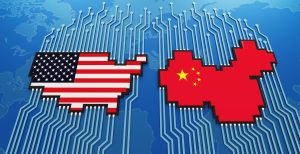- Sponsored
- Insights
Defense leaders on accelerating mission with AI and security

Across the defense community, organizations are piloting projects and setting up task forces aimed at improving artificial intelligence integration into mission operations. In a recent interview series, defense leaders share their evolving cloud and AI strategies to drive mission outcomes, scale operations and secure their data and workloads.
In the series, “Accelerating the Mission with AI and Security,” produced by Scoop News Group for DefenseScoop, and underwritten by Google for Government, leaders overarchingly agreed that AI, and the new subset generative AI, will define technology modernization trends across their agency.
Improving security resilience with AI
AI will be an invaluable tool for organizations to automate security data analysis and the response and remediation of threats, leaders say.
DISA technical director Andrew Malloy shares how the Cyber Development Directorate is exploring AI’s use as a “force multiplier when it comes to being able to auto-correct, auto-block certain things, to look at different malware variants and know what to do and what not to do.”
He surmises that AI tools on the commercial side could be leveraged to train models on government data for tasks such as training users and improving knowledge management within organizations.
Several leaders in the series cited specific projects across defense agencies that are currently being spun up to better understand AI implementation using appropriate frameworks. Gary Buchanan, CISO at the National Geospatial-Intelligence Agency, highlights as an example Project Maven, a DOD-based AI intelligence system that helps NGA understand how AI can work within their infrastructure.
“From a defensive standpoint, we’ve been partnering with Gartner to understand how we can structure AI within our system so that it’s not, it doesn’t run rampant across places where it shouldn’t make sure it has access to the data that it should, and not the data that it shouldn’t,” he explained.
AI for data analysis and prediction models
The pace of innovation of AI models and the computing tools required to make use of this technology is within reach of a lot of organizations. However, having a sound understanding of the infrastructure needs, data hygiene practices, and use cases are essential to ensuring a sound investment strategy.
“When people think of AI, a lot of people think of it as a ‘magic wand,’ that if you ‘buy’ AI, then magically all of your problems will be solved,” quipped Jinyoung Englund, acting DCDAO for digital services at the DOD. “But the reality is, if you want to use AI, you first have to have infrastructure, you have to have quality data, you have to have cloud capabilities, you have to have accelerated compute.”
She explains that her office invests in building the infrastructure to enable other defense organizations to then deploy AI capabilities, such as by establishing an AI marketplace. For example, DOD has established ai.com as the place for industry players to register the AI tools and services they want to provide to their DOD customers.
“In the future, I’m hard-pressed to think of a program that isn’t going to employ AI in some ways,” added Winston Beauchamp, deputy CIO for the Air Force. “Certainly, for our flying platforms, assisting a pilot to make sense of the barrage of information that they face is a job well suited for AI. Same thing for space operations, as well as the business side of the house, logistics maintenance planning — every function has some role that can be better accomplished by use of AI as an assist to the folks who perform those missions.”
Duncan McCaskill, acting chief data and chief analytics officer at the Department of Navy touched on the power of generative AI to improve how personnel access information, stressing the importance of ensuring data is clean and made available to more modern cloud systems.
“So instead of someone aboard a ship, having to page through all kinds of paper manuals, we could get to the point where there’s a digital assistant [able to access] every technical manual for that particular vessel,” he said.
AI to accelerate workforce collaboration
Defense leaders also share how AI-assisted tools and platforms can streamline communication and workloads across the defense community at large to reduce productivity bottlenecks.
Among them is Jude Sunderbruch, the executive director of the DOD’s Cyber Crime Center, which provides cybersecurity training and services that support the defense industrial base.
He shares that their unit’s biggest challenge is making sure it is working in partnership with all stakeholders and building connections that can operate at scale and quickly. Improving data tagging and data governance across the organizations allows it to appropriately share information, validate origination, secure information, and ensure lawful compliance with all the applicable rules.
“Hopefully over time, applying more artificial intelligence and machine learning tools is really where we’re headed,” said Sunderbruch.
Among the many IT investments organizations are making, leaders point to the value of continuous learning and education of their workforce to keep up with these changes.
Eileen Vidrine, chief data and artificial intelligence officer for the Air Force made that clear, saying, “I would say our biggest challenge is always going to be talent. We want the absolute best in our workforce, total force, military, civilian active guard reserve. And we have that in common with our industry colleagues because the competition for the best talent is fierce right now. So we have to have really invest in multiple ways to bring in great capability.”
She stressed the value of offering education opportunities like data science or offering internships and other pathways for recent college graduates but also noted the importance of upskilling the Air Force’s existing workforce and continuing to invest in skills acquisition geared towards career growth.
Other participants who shared their insights in this series included:
- Maynard Holliday, PTDO Assistant Secretary of Defense, Critical Technologies, DOD
- Justin Fanelli, Acting CTO, Department of Navy
- Peter Guo, CIO, Ships Repair Facility, Department of Navy
- Dan Berrigan, Ph.D., Lead, Worldwide Research Collaboration, Digital Capabilities Directorate, Air Force Research Laboratory
- Sean Baker, Chief Technology and Senior Information Security Officer, Uniformed Services University
This video series was produced by Scoop News Group, for DefenseScoop, and sponsored in part by Google for Government.






